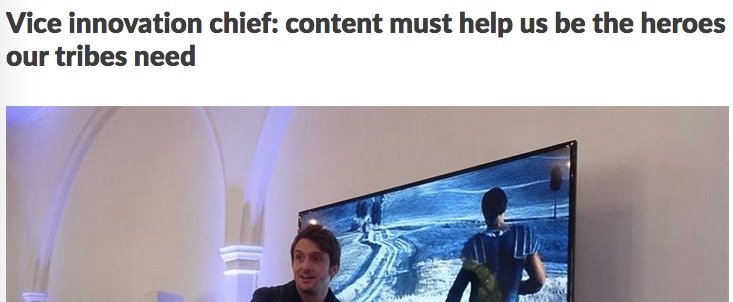Save 50% on a 3-month Digiday+ membership. Ends Dec 12.

It was the most wonderful time of the year: Advertising Week. Digiday was, of course, all over it like a donkey on a waffle. Nas and Sarah Jessica Parker were there. And because there were official cameras and raised daises, WPP’s Sir Martin Sorrell was there and probably didn’t sleep all week.
Give or take 10,000, how many times do you think the words “transform” and “transformation” were said by woke “transformers” (formerly known as unwoke “marketers”)?
To be sure, buzzwords, both stale (“big data”) and fresh (“conversational data”), were flying into participants’ ears like gnats. Rarely does the English language face such a brutal four-day assault. It’s gotta be getting hard for a thought leader to stay “plugged in” (pre-wireless jargon). We’ve grabbed some recent marketing headlines to try to help out.

To be “head of innovation” at super woke Vice, shit, you must have to be, like, so woke. This recent Campaign article begins, “The progression of digital technology has pulled people into tribes [made up of squads?] that content producers must speak the language of,” says Mr. Innovation (pictured). He also says good storytelling adheres to the structure of the “hero’s journey.”
But how can we creatives content-doers create stories that “adhere” to a tribe’s hero’s journey if we don’t yet know who the real actual hero is or even the “structure” of where he/she is going (let alone, what language they speak)? And how do we know the tribe will not cook the hero but follow him/her? What if the hero ends up not buying the “product”? If he/she does complete the “journey,” do we call her/him a “product hero”?

Both of these recent posts are via Adweek. What’s the difference between brand and digital transformation? I think digital transformation is when you’re transported somewhere digitally, a la Star Trek. The brand transformation piece was via Dmexco earlier this month and proffers that “stirrings of meaningful brand transformation … will continue only if legacy insight silos collapse.” Collapsed insight silos only gets you “stirrings”? There must be another less violent way.

The advertising Knight didn’t make up that very visual metaphor, but the industry reported it like he did. What if you’re observing the elephant using Snapchat “Spectacles,” and you spy several fleas? Or an oxpecker? Should you then increase your Snapchat budget? What if somebody buys out your entire elephant? Sorrell has not yet responded to email queries.

Above: a sponsored post on Adweek. Wait, isn’t it the age of “people-based marketing”? Should that be updated to “person-based marketing”? And are we sure millions and millions of people want/expect that level of human-on-brand intimacy? What if they all want to “engage” in a one-on-one with the CMO or CEO? How much should you charge extra for that encounter? Maybe it’s time to create AI and VR versions of your marketing execs or dirty chatbots.
Previously: Deciphering meaningless marketing headlines
More in Marketing

In Graphic Detail: Here’s what the creator economy is expected to look like in 2026
Digiday has charted its expected revenue, key platforms for creator content as well as what types of creators brands want to work with.

Ulta, Best Buy and Adidas dominate AI holiday shopping mentions
The brands that are seeing the biggest boost from this shift in consumer behavior are some of the biggest retailers.

Future of Marketing Briefing: AI confuses marketers but their own uncertainty runs deeper
That was the undercurrent at this week’s Digiday Programmatic Marketing Summit in New Orleans.








